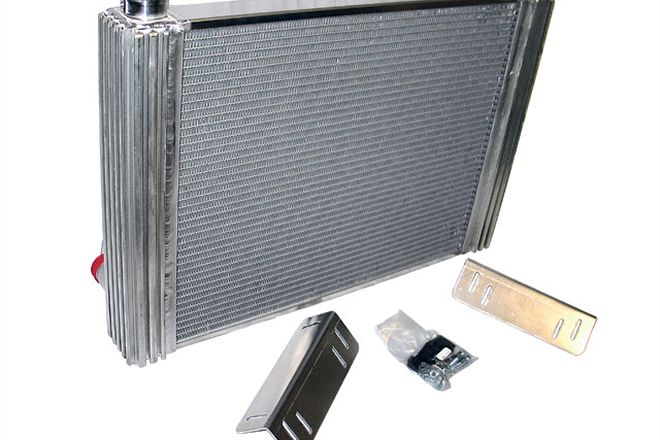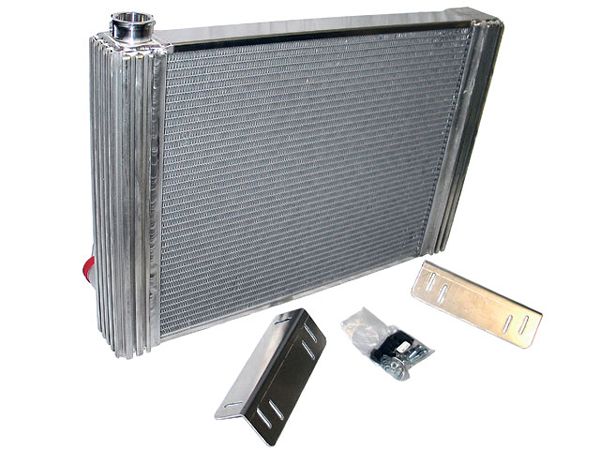
 Christian Hazel
Brand Manager, Four Wheeler
Christian Hazel
Brand Manager, Four Wheeler

It seems that some rigs with swapped-in engines always run hot. But they don't have to. Even if you can't fit a large radiator in your Jeep's engine compartment, there are ways to increase the amount of heat energy you're able to remove from your cooling system.
Because we're planning on running a 455 big block with nearly 500hp in our Project Murderous Overkill '48 Willys truck, we knew we'd have to remove a large amount of Btu with a small amount of radiator space. We contacted Flex-a-lite for our solution and to learn a bit more about selecting the right radiator for your vehicle.
The very, very general rule of thumb for choosing the right radiator for your vehicle is that you want at least 1 square inch of radiator core surface area for every cubic inch of engine displacement. However, this doesn't really take into account radiator efficiency or power output of the engine. Just like one 350-cubic-inch engine may produce 200hp while another 350-cubic-inch engine produces 500hp, one 18x27-inch radiator may remove way more Btu of heat energy than another 18x27-inch radiator.
Use the 1 square inch per 1 cubic inch as a very loose and general guideline when choosing your radiator. Just remember that if your engine makes more than average horsepower, is turbocharged or supercharged, or has inefficiently designed cooling passages, you'll want to err on the larger side when selecting your radiator. However, if the radiator you choose is more efficient than the normal radiator, as is our Flex-a-lite unit, you can fudge the numbers a little and run a smaller radiator than what the formula calls for.
Back in the early days, when only copper and brass radiators were used, it was generally understood that more cores equated into better cooling ability, hence the prevalence of monstrous four-core radiators. However, with the use of high-flow aluminum cores, it's possible to rival and surpass the cooling of an older two-core radiator with a single 1-inch aluminum radiator. An aluminum radiator with two 1-inch cores can outperform a three- or four-core copper and brass radiator.
This isn't because aluminum is better at dissipating heat. In fact, copper is a much more efficient dissipater of heat and brass has much better corrosion resistance than aluminum. But to save weight, manufacturing time, and money, vehicle manufacturers switched to aluminum and made the cores efficient by designing the tubes for the best flow and better coolant distribution throughout the radiator.
Although the radiator cores are a big part of the equation, the radiator tanks also have their role in the amount of heat that's able to be shed from a radiator. This is where Flex-a-lite's Flex-a-fit radiator does an exceptional job of combining an easily welded, all-aluminum construction with better heat-shedding characteristics than a soldered copper and brass radiator. Check out the sidebar, "Locked in the Heat Shed" for more info on Flex-a-lite's testing using common radiator tank materials.
The secret to the Flex-a-fit radiator lies in its revolutionary extruded aluminum radiator tanks. The fins not only act as solid mounting points for electric fans, auxiliary coolers, and the radiator mount, but they shed heat 114 percent more efficiently than a standard OEM brass tank. The added head shedding of these fins allows us to run a much smaller radiator in front of our 500hp engine than we normally could for fender and hood clearance inside the cramped Willys engine compartment.
Tank type: Aftermarket-stamped aluminum performance OEM plastic OEM brass/copper Flex-a-fit extruded aluminum Heat-shedding capability per hour: {{{929}}}.4 Btu/hr 1069.8 Btu/hr 1552.6 Btu/hr 2187.0 Btu/hr

